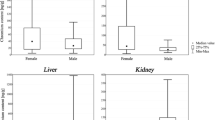Summary
The detectability of metals and drugs in histological organ parts embedded in paraffin was tested in 24 cases, which had been analyzed before. The liver, kidney and brain parts were separated from the paraffin by heating the paraffin up to 110°C and were homogenized by means of Ultra-Turrax blendor and ultrasound. Analysis was realized using gas chromatography, atomic absorption and mass spectrometry. Only 1.5%–4% of the original quantities of metals (As, Tl, Hg) was found in the embedded organs. Drugs could not be detected except for a low percentage of phenobarbital (2 cases) and bromine (3 cases). Reliable estimations cannot be made about the concentrations in the organs before the embedding procedure.
Zusammenfassung
Die Nachweisbarkeit von Schwermetallen und Arzneistoffen in den in Paraffin (Paraplast) eingebetteten histologischen Organteilen wurde an 24 zuvor toxikologisch abgeklärten Vergiftungsfällen untersucht. Die Organteile von Leber, Niere und Gehirn wurden bei 110°C aus den Paraffinblöcken geschmolzen, mit Ultra-Turrax und Ultraschall homogenisiert und mittels Atomabsorption, Gaschromatographie und Massenspektrometrie analysiert. Die Schwermetalle (Arsen, Thallium, Quecksilber) waren in stark reduzierter Konzentration (1,5–4% des Ausgangswertes) nachweisbar. Von den Arzneistoffen konnten lediglich geringe Mengen Phenobarbital (2 Fälle) und Bromid (3 Fälle) nachgewiesen werden. Eine zuverlässige Rückrechnung auf die ursprünglichen Konzentrationen ist jedoch auch in positiven Fällen nicht möglich.
Similar content being viewed by others
Literatur
Algeri EJ (1957) The determination of barbiturate after putrefaction. J Forensic Sci 2:443–455
Klug E (1982) Zum Nachweis von Arzneistoffen in formalinfixierten Organteilen. Beitr Gerichtl Med 40:407–411
Schmidt G (1962) Detection and estimation of barbituric acid derivatives. Methods of Forensic Science, vol I, p 423, Interscience Publ
Sunshine I, Hackett E (1957) Chemical findings in cases of fatal barbiturate intoxications. J Forensic Sci 2:149–158
Thiess D (1967) Möglichkeiten toxikologisch-chemischer Analytik an gelagerten formaldehydfixierten Organasservaten. Z Anal Chem 229:43–45
Thiess D (1969a) Zur Schnelldiagnostik von Vergiftungsmitteln an chemisch unveränderten Mageninhaltsproben und formaldehydhaltigen Organfixantien mittels UV-Spektrometrie. Dtsch Gesundheitswes 37:1755–1758
Thiess D (1969b) Modelluntersuchungen zur direkten UV-spektrophotometrischen Bestimmung von Arzneimitteln in Formaldehydlösungen. Pharmazie 24:595–598
Author information
Authors and Affiliations
Additional information
Auszugsweise als Vortrag auf der 15. Arbeitstagung Norddeutscher Rechtsmediziner am 25./26.05.84 in Münster gehalten
Rights and permissions
About this article
Cite this article
Klöppel, A., Weiler, G. Zur Nachweisbarkeit von Giften in paraffineingebetteten Organteilen. Z Rechtsmed 93, 269–272 (1984). https://doi.org/10.1007/BF00198652
Received:
Issue Date:
DOI: https://doi.org/10.1007/BF00198652




